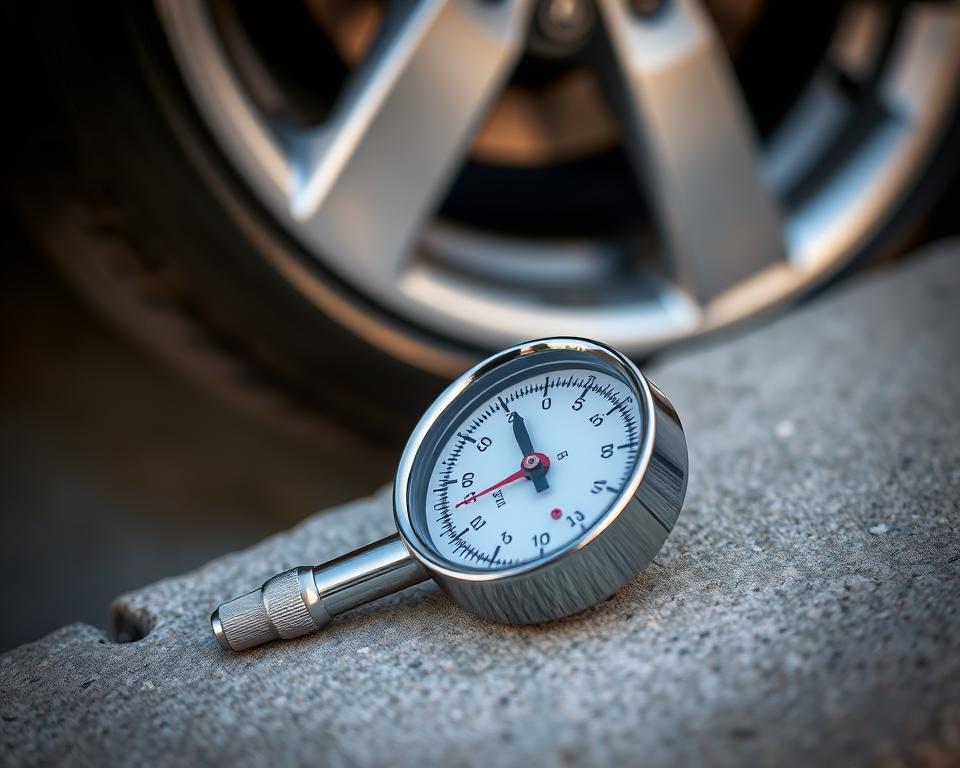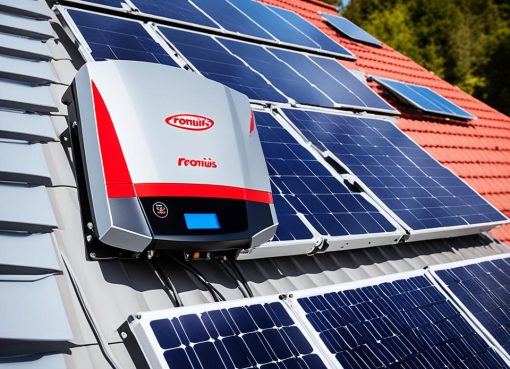Accurate Tire Pressure Gauge: Measure with Precision

Keeping your tires at the right pressure is key for your car’s performance, safety, and how much fuel it uses. An accurate tire pressure gauge is a must-have for making sure your tires are at the levels recommended by the maker. Whether you’re an experienced driver or new to cars, knowing the value of a good tire pressure gauge is crucial. It helps keep your car running smoothly.
Read interesting things at : intarajyuku
Key Takeaways
- An accurate tire pressure gauge is essential for maintaining proper tire inflation levels.
- Properly inflated tires improve vehicle handling, braking, and fuel efficiency.
- Tire pressure gauges come in digital and analog varieties, each with their own features and benefits.
- Choosing the right tire pressure gauge for your needs depends on factors like accuracy, ease of use, and durability.
- Regularly checking and adjusting tire pressure can help extend the life of your tires and ensure a safe, smooth ride.
Introduction to Tire Pressure Gauges
Keeping your tires at the right pressure is key for safety and performance. Tire pressure gauges are vital tools for checking and adjusting tire air pressure. They help make sure your tire pressure monitoring system works right, keeping you safe and your tires lasting longer.
Importance of Proper Tire Inflation
Right tire pressure brings many benefits. It improves fuel use, handling, and tire life. Too little air makes tires use more gas and wear out faster. Too much air can make the tread wear unevenly and reduce grip, risking your vehicle safety equipment.
Checking tire pressure regularly with a good gauge is crucial. It keeps your vehicle safe and running well.
Types of Tire Pressure Gauges
Tire pressure gauges vary in style and function. The main types are digital and analog:
- Digital Tire Pressure Gauges: These modern tools give a precise digital reading of air pressure. They can also store and recall past readings.
- Analog Tire Pressure Gauges: These traditional gauges show air pressure on a mechanical dial. They might not be as precise but are often cheaper and more durable.
Having a quality tire pressure gauge is vital for every driver. It ensures your tires perform well and stay safe.
| Feature | Digital Tire Pressure Gauges | Analog Tire Pressure Gauges |
|---|---|---|
| Readout | Digital display | Mechanical dial |
| Precision | Highly accurate | Slightly less precise |
| Durability | May be more fragile | Generally more durable |
| Cost | Typically more expensive | Often more affordable |
Digital Tire Pressure Gauges
Digital tire pressure gauges have changed the game in tire maintenance. They offer features that make them a top choice for drivers. These tools provide precise and easy-to-use tire pressure monitoring.
Features and Benefits
Digital tire pressure gauges have many features that set them apart. They often have backlit displays for easy reading in the dark. They also have automatic shut-off to save battery life.
Some models can switch between different units of measurement. This is great for drivers all over the world.
Accuracy and Ease of Use
Digital tire pressure gauges are known for their accuracy. They use advanced sensors for precise measurements. This is important for keeping tires at the right pressure.
These gauges are also easy to use. They have large displays that show the tire pressure clearly. This makes them a must-have for drivers who want to keep their vehicle in top shape.
| Feature | Benefit |
|---|---|
| Backlit Display | Improved visibility in low-light conditions |
| Automatic Shut-Off | Preserves battery life for long-lasting use |
| Unit Conversion | Accommodates personal preferences and global standards |
| Precision Sensors | Provides accurate tire pressure readings |
| User-Friendly Design | Easy to operate and interpret tire pressure information |
Analog Tire Pressure Gauges
Analog tire pressure gauges are still a top pick for many drivers. They offer features and benefits that make them a solid choice for keeping tires at the right pressure.
One big plus of analog automotive air pressure tools is how easy they are to use. They show tire pressure with a simple mechanical design. This makes them great for those who like a more classic way of doing things or are not into digital tech.
These gauges are also known for lasting a long time. Unlike digital ones that might need batteries or electronics that can break, analog automotive air pressure tools can handle daily use and tough conditions. They’re perfect for drivers who need a reliable tire pressure gauge.
| Feature | Analog Tire Pressure Gauges | Digital Tire Pressure Gauges |
|---|---|---|
| Mechanism | Mechanical | Electronic |
| Durability | Highly durable, long-lasting | May require battery replacement or be more susceptible to damage |
| User Experience | Straightforward, intuitive | May require more technical understanding |
| Cost | Generally more affordable | May be more expensive |
Another advantage of analog analog tire gauges is their lower cost. This makes them a good choice for those watching their budget or who might need to replace their gauge often.
Even though digital gauges have cool features and are very precise, many drivers still prefer analog ones. Their ease of use, durability, and lower price make them a key tool for keeping tires in good shape.
Choosing the Right Tire Pressure Gauge
Choosing the right tire pressure gauge is key for safe driving. It ensures your tires are properly inflated. Look at several factors to find the best gauge for your vehicle.
Factors to Consider
Accuracy, ease of use, and compatibility are crucial. A gauge that gives accurate readings is vital for your safety and fuel efficiency. Look for one that is precise.
- Accuracy: Choose a gauge that’s accurate to ±1 PSI or better. This ensures reliable readings.
- Ease of Use: The gauge should be easy to read and use. It should also switch between units like PSI, kPa, or Bar.
- Compatibility: Make sure the gauge fits your vehicle’s tire valve stems. Some gauges won’t fit all stems, so check the specs.
Also, think about the gauge’s durability and portability. Some gauges come with extra features like remote tire pressure monitoring. This can be part of your vehicle safety equipment.
By considering these factors, you can find a tyre pressure gauge that’s accurate, easy to use, and fits your vehicle. This will help keep your vehicle safe and running well.
Understanding Tire Pressure Monitoring Systems (TPMS)
Modern cars have a safety feature called Tire Pressure Monitoring Systems (TPMS). These systems give you real-time info on your tires’ air pressure. They help you keep the right pressure and make driving safer.
How TPMS Works
TPMS uses sensors in each tire to watch the air pressure. These sensors send data to a control unit. Then, the unit shows the info on your dashboard.
TPMS alerts you to any tire pressure changes. This lets you fix the issue right away. So, your tires stay at the right pressure.
TPMS works with a tire pressure gauge. The gauge lets you check and adjust pressure manually. But TPMS keeps an eye on it for you, always.
Using TPMS with a tire pressure gauge is smart. It helps you manage your car’s tpms, pressure monitoring systems, and vehicle safety equipment. This combo keeps your tires at the right pressure. It improves fuel use, handling, and safety on the road.
Tyre Pressure Gauge: A Must-Have Tool
Keeping your tires at the right pressure is key for safety, better fuel use, and longer tire life. A good tyre pressure gauge is a must-have for every driver.
Having a tyre pressure gauge lets you check and adjust your tire pressure often. This can greatly improve your car’s performance and safety. Proper pressure makes your car handle better and reduces the chance of a sudden tire blowout.
- Maintain optimal tire pressure for improved fuel economy and reduced carbon emissions.
- Extend the lifespan of your tires by preventing premature wear and tear.
- Enhance your vehicle’s handling and responsiveness for a safer and more enjoyable driving experience.
A tyre pressure gauge is not just a safety tool but also saves you money. It helps your tires last longer and work better. Getting a good tyre pressure gauge is a smart move for car care and the planet.
“Properly inflated tires are the foundation of safe, efficient, and economical driving.”

Whether you’re a pro mechanic or a new driver, a tyre pressure gauge is vital. Make it a habit to check and adjust your tire pressure. You’ll see the difference it makes in your car’s performance and your safety.
Proper Tire Inflation Techniques
Getting your tire pressure right is key for your car’s performance, safety, and gas use. To inflate your tires correctly, use this guide with a tire pressure monitor or other tools.
Step-by-Step Guide
- Find the recommended tire pressure for your car. Look in the driver’s side door jamb, owner’s manual, or tire information placard.
- Check the current pressure in each tire with a reliable gauge, like digital or analog. Vehicle air compressors help with this.
- If the pressure is too low, add air with a tire inflator or compressor. Don’t overinflate.
- After inflating, check the pressure again with your gauge to make sure it’s right.
- Do this for all four tires and the spare to keep pressure even across your vehicle.
It’s important to check and keep your tire pressure up with a tire pressure monitor or other tools. This ensures your tires work well, save gas, and keep you safe.
| Tire Pressure Gauge Type | Accuracy | Ease of Use | Durability |
|---|---|---|---|
| Digital Tire Pressure Gauge | High | Easy | Moderate |
| Analog Tire Pressure Gauge | Moderate | Simple | High |
“Maintaining the proper tire pressure is one of the most important things you can do to ensure your vehicle’s safety and efficiency.”
By following these steps and using the right tools, you can keep your tires at the right pressure. This makes for a smooth, safe, and gas-saving ride.
Maintaining Accurate Tire Pressure
Keeping your vehicle’s tires at the right pressure is key for safety and better fuel use. It’s important to check and adjust the pressure regularly. We’ll look at how often to check and the best ways to do it.
Frequency of Tire Pressure Checks
It’s wise to check your tyre pressure gauge monthly or before long drives. This makes sure your tires are at the right pressure. You can find the recommended levels in your owner’s manual or on a sticker on the driver’s side door jamb.
Best Practices for Tire Pressure Maintenance
- Check tire pressure when the tires are cold, meaning you’ve driven less than a mile or the vehicle has been parked for at least three hours.
- Use a reliable and accurate tire pressure monitoring device, such as a digital or dial tyre pressure gauge.
- Adjust the tire pressure to the recommended PSI (pounds per square inch) levels, which can vary depending on the vehicle and tire type.
- Regularly inspect your tires for any signs of wear, damage, or uneven inflation, which can indicate a problem with your vehicle safety equipment.
- If you notice a significant change in tire pressure, investigate the cause and address it promptly to maintain optimal performance and safety.
By sticking to these tips and keeping your tire pressure right, you’ll make your tires last longer. You’ll also improve your car’s handling and fuel use. Plus, you’ll drive safer.
| Tire Pressure Monitoring Frequency | Recommended PSI Range |
|---|---|
| Monthly or before long trips | 30-35 PSI (for most passenger vehicles) |
“Properly inflated tires are the foundation of vehicle safety and performance. Regular tire pressure monitoring is a simple, yet often overlooked, maintenance task that can pay big dividends.”
Benefits of Proper Tire Pressure
Keeping your tires at the right pressure is key for your car’s performance, safety, and fuel use. Properly inflated tires offer many benefits. They make driving better and can save you money in the long run.
Improved Fuel Efficiency
Tires at the right pressure need less effort to roll. This means your car’s engine works less hard. You’ll use less fuel, saving money on gas over time.
Extended Tire Lifespan
Underinflated tires wear out faster. Overinflated ones can wear unevenly. Keeping the tire pressure right makes your tires last longer. This saves you money on early replacements.
Enhanced Safety
Right pressure tires grip the road better, handle well, and stop safely. They’re key for your safety. Underinflated tires can blow out, raising accident risks. A good tire pressure monitor or automotive air pressure tools keeps your tires safe.
| Benefit | Description |
|---|---|
| Fuel Efficiency | Properly inflated tires reduce rolling resistance, leading to improved fuel economy and lower fuel costs. |
| Tire Lifespan | Maintaining the correct tire pressure helps extend the lifespan of your tires, saving you money on premature replacements. |
| Safety | Correctly inflated tires provide better traction, handling, and braking, reducing the risk of accidents and ensuring a safer driving experience. |
By keeping your tires properly inflated, you’ll enjoy a more efficient, safe, and cost-effective driving experience. Investing in a reliable tire pressure monitor or automotive air pressure tools can help you maintain optimal tire pressure and unlock the full benefits of proper tire maintenance.

Safety Considerations
Keeping your tires at the right pressure is key for safety, not just fuel savings. The wrong pressure can affect how your car handles and stops. This can be dangerous for everyone inside.
Risks of Underinflated Tires
Underinflated tires are a big safety risk. They flex more, leading to higher temperatures and wear. This means they stop slower and handle worse.
They’re also more likely to blow out. This can be very dangerous while driving.
Risks of Overinflated Tires
Overinflated tires are risky too. They don’t grip the road as well, making it easier to skid. This is especially true in wet weather.
They also wear unevenly, which affects their grip. This can make driving more dangerous.
To stay safe, use a tpms or automotive air pressure tools to check your tire pressure. A good tire pressure gauge helps catch problems early. This keeps everyone safe on the road.
“Proper tire inflation is not just about fuel efficiency – it’s a critical aspect of vehicle safety. Underinflated or overinflated tires can significantly compromise your vehicle’s handling and stability, putting you and your passengers at risk.”
Additional Tire Care Tips
Keeping your vehicle’s tires in top shape is more than just checking air pressure. Here are some extra tips to keep your tires in great condition:
Tire Rotation
Rotating your tires every 5,000 to 8,000 miles helps them wear evenly. This means moving the tires to different spots on your vehicle. It spreads out the wear and tear.
Wheel Alignment
Having your wheels aligned right is key for even tire wear and a smooth ride. Check your alignment yearly or if you notice uneven wear or your car pulling to one side.
Tire Inflators and Air Compressors
Getting a good car tire inflator or vehicle air compressor makes it easy to keep the right tire pressure monitoring. These tools help you inflate your tires correctly. This boosts performance and saves fuel.
| Tire Care Tip | Benefit |
|---|---|
| Tire Rotation | Promotes even wear and extends tire life |
| Wheel Alignment | Ensures smooth, safe driving and even tire wear |
| Tire Inflators and Air Compressors | Allows for accurate tire pressure monitoring and adjustment |
Adding these tire care tips to your routine will keep your tires healthy and performing well. This makes driving safer and more fun.
Conclusion
A reliable tire pressure gauge is key for every driver. It helps keep your vehicle’s tires in top shape. This leads to better safety, fuel use, and tire life.
Regularly checking and adjusting tire pressure is important. It’s a simple step to keep your car running well and safe on the road.
The tire pressure monitor is a great vehicle safety equipment. It tells you when your tire pressure is off. Using a tire pressure gauge regularly helps you fix issues before they get worse.
Choosing the right tyre pressure gauge is crucial. Whether it’s digital or analog, pick one that’s accurate and fits your needs. Keeping an eye on tire pressure ensures a safer, more efficient, and longer-lasting drive.



Leave a Comment